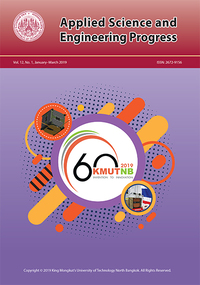Characterization of Graphene Synthesized by Modified Hummers and Liquid-phase Exfoliation Method
Main Article Content
Abstract
Graphene was synthesized through chemical cleavage followed by reduction process and through liquid-phase exfoliation methods. The characteristics of synthesized graphene were investigated by Raman spectroscopy, FTIR, SEM, XRD and UV-Visible spectrophotometry. It was found that Graphene Oxide (GO) synthesized by modified Hummer’s method had carboxylic acid, hydroxyl, and ether groups confirming that graphite was successfully oxidized. The result also showed that graphene oxide consisted of 12 layers and the layer distance was in the range of 0.67–0.72 nm. In liquid-phase exfoliation method, graphene sheets were synthesized by mixing graphite with naphthalene and N-methyl-2-pyrrolidone (NMP) followed by sonication. The results indicated that the inter layer spacing of graphite was expanded from 0.3356 to 0.3364 nm. The highest graphene concentration was up to 3.26 mg/mL and the yield was 54.34%.
Article Details
References
[2] K. E. Whitener Jr and P. E. Sheehan, “Graphene synthesis,” Diamond and Related Materials, vol. 46, pp. 25–34, 2014.
[3] Y. Zhang, L. Zhang, and C. Zhou, “Review of chemical vapor deposition of graphene and related applications,” Accounts of Chemical Research, vol. 46, pp. 2329–2339, 2013.
[4] L. Shahriary and A. A. Athawale, “Graphene oxide synthesized by using modified Hummers approach,” International Journal of Revolution in Electrical and Electronic Engineering, vol. 2, pp. 58–63, 2014.
[5] G. Shao, Y. Lu, and F. Wu, “Graphene oxide: The mechanisms of oxidation and exfoliation,” Journal of Materials Science, vol. 47, pp. 4400–4409, 2012.
[6] J. Xu, D. K. Dang, V. T. Tarn, X. Liu, J. S. Chung, S. H. Hur, W. M. Choi, E. J. Kim, and P. A. Kohl, “Liquid-phase exfoliation of graphene in organic solvents with addition of naphthalene,” Journal of Colloid and Interface Science, vol. 418, pp. 37–42, 2014.
[7] R. Durge, R. V. Kshirsagar, and P. Tambe, “Effect of sonication energy on the yield of graphene nanosheets by liquid-phase exfoliation of graphite,” Procedia Engineering, vol. 97, pp. 1457–1465, 2014.


